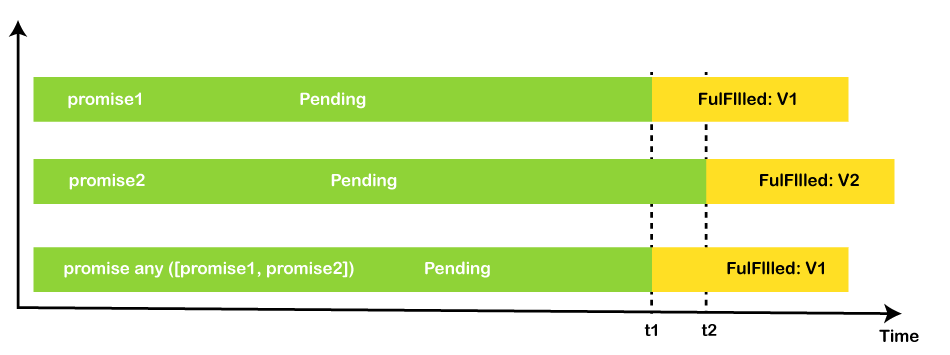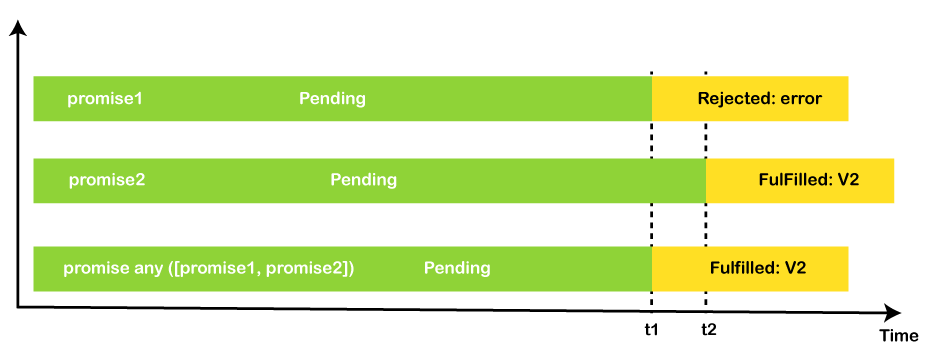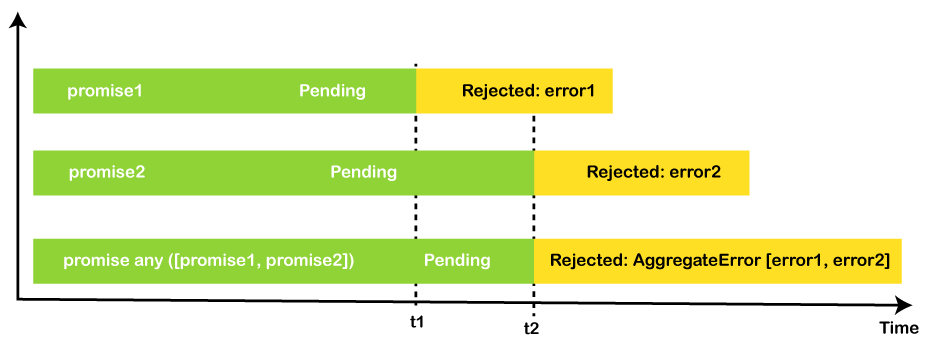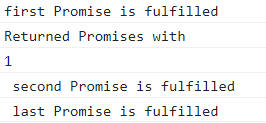JavaScript Promise.any() MethodWhenever one of the promises we provided inside the iterable object-like array is properly fulfilled or resolved, the procedure returns a promise that either accepts or rejects. A promise. One of the concurrency promise methods is the any() one. Returning the first fulfilled promise using this way is helpful. Once a promise is fulfilled, it short-circuits instead of waiting for the other promises to follow. Promise.Any() is resolved as soon as one or more of the promises you pass is satisfied, or it is refused with an AggregateError if all promises are unfulfilled. SyntaxThe following syntax shows the Promise.any() method with input promise arguments. Explanation: Promise.any() delivers a single promise which resolves to a value that is the outcome of the fulfilled promise when any of the promises in the array object is fulfilled. Return Value: The following values are returned by this method: An already-fulfilled Promise is returned if the supplied parameter is void. The values and specific statuses of each promise passed into it are included in a pending promise created in all other cases.
Working procedure of the promise.any() method
DiagramsInput argument Diagram The Promise.any() method with all promises fulfilled operation is shown in the diagram below: 
Even if some of the promises in the iterable object are rejected, any() delivers a promise that is fulfilled for any first fulfilled promise: Input argument Diagram The Promise.any () method's with one promise rejected and other promises fulfilled operation is shown in the diagram below: 
Keep in mind that the Promise.any() method disregards the broken promise (promise1).
Input argument Diagram The Promise.any() method with all promises rejected operation is shown in the diagram below: 
A mistake1 at time1 causes the promise1 to be rejected. Promise2 is turned down at time two due to an error2. The AggregateError returned by the Promise.any() method contains the error1 and error2 of all the promises that were rejected together with a promise that was rejected at time t2. Examples of JavaScript Promise.any() methodThe examples promise any() with all of the input Promises. We can create all promises fulfilled, rejected or rejected or fulfilled. Example 1: The basic JavaScript's Promise.any() method for results and value with input argument. Using the method, we can get the undefined value and result status with time. Output The image shows all the resolved values of the promise.any() method. 
Example 2: The example shows promises with one rejected and one resolved using the promise method. Here we use multiple promises with a period for the operation. Output The image shows the one rejected and one resolved value of the promise.any() method. 
Example 3: The example shows promises with all rejected using the promise method. Here we use multiple promises with the required time for the functionality. Output The image shows all the rejected values of the promise.any() method. 
Example 4: The promise.any() method uses the then, catch, and finally categories to fulfill operation and display output. We can use all the methods with the promise.any() iterable empty value. The finally function calls the input information and displays it as an output. Output The console tab displays output with the aggregate information. 
When to utilize the Promise.any() method in JavaScriptTo provide a first fulfilled promise in practice, use the Promise.any() method. The Promise.any() function does not hold back until all promises have been fulfilled. In other words, when a promise is fulfilled, the Promise.any() function shorts out. You might have a resource used by two or more networks that deliver content, for instance (CDN). The Promise.any() method can be used to dynamically load the first resource that becomes accessible. Example The next example retrieves two photos using the Promise.any() method and shows the first available one. Output The output shows one image as promise data, and one image rejected. 
How it operates
ConclusionTo determine which promise out of a list satisfies first, use the JavaScript Promise.any() method.
Next TopicObject.key() in JavaScript
|
 For Videos Join Our Youtube Channel: Join Now
For Videos Join Our Youtube Channel: Join Now
Feedback
- Send your Feedback to [email protected]
Help Others, Please Share









